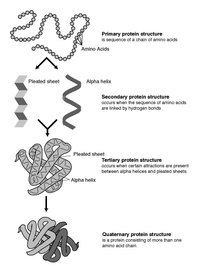
Photo from wikipedia
We treat protein folding as molecular self-assembly, while unfolding is viewed as disassembly. Fracture is typically a much faster process than self-assembly. Self-assembly is often an exponentially decaying process, since… Click to show full abstract
We treat protein folding as molecular self-assembly, while unfolding is viewed as disassembly. Fracture is typically a much faster process than self-assembly. Self-assembly is often an exponentially decaying process, since energy relaxes due to dissipation, while fracture is a constant-rate process as the driving force is opposed by damping. Protein folding takes two orders of magnitude longer than unfolding. We suggest a mathematical transformation of variables, which makes it possible to view self-assembly as time-reversed disassembly, thus folding can be studied as reversed unfolding. We investigate the molecular dynamics modelling of folding and unfolding of the short Trp-cage protein. Folding time constitutes about 800 ns, while unfolding (denaturation) takes only about 5.0 ns and, therefore, fewer computational resources are needed for its simulation. This RetroFold approach can be used for the design of a novel computation algorithm, which, while approximate, is less time-consuming than traditional folding algorithms.
Journal Title: Royal Society Open Science
Year Published: 2023
Link to full text (if available)
Share on Social Media: Sign Up to like & get
recommendations!